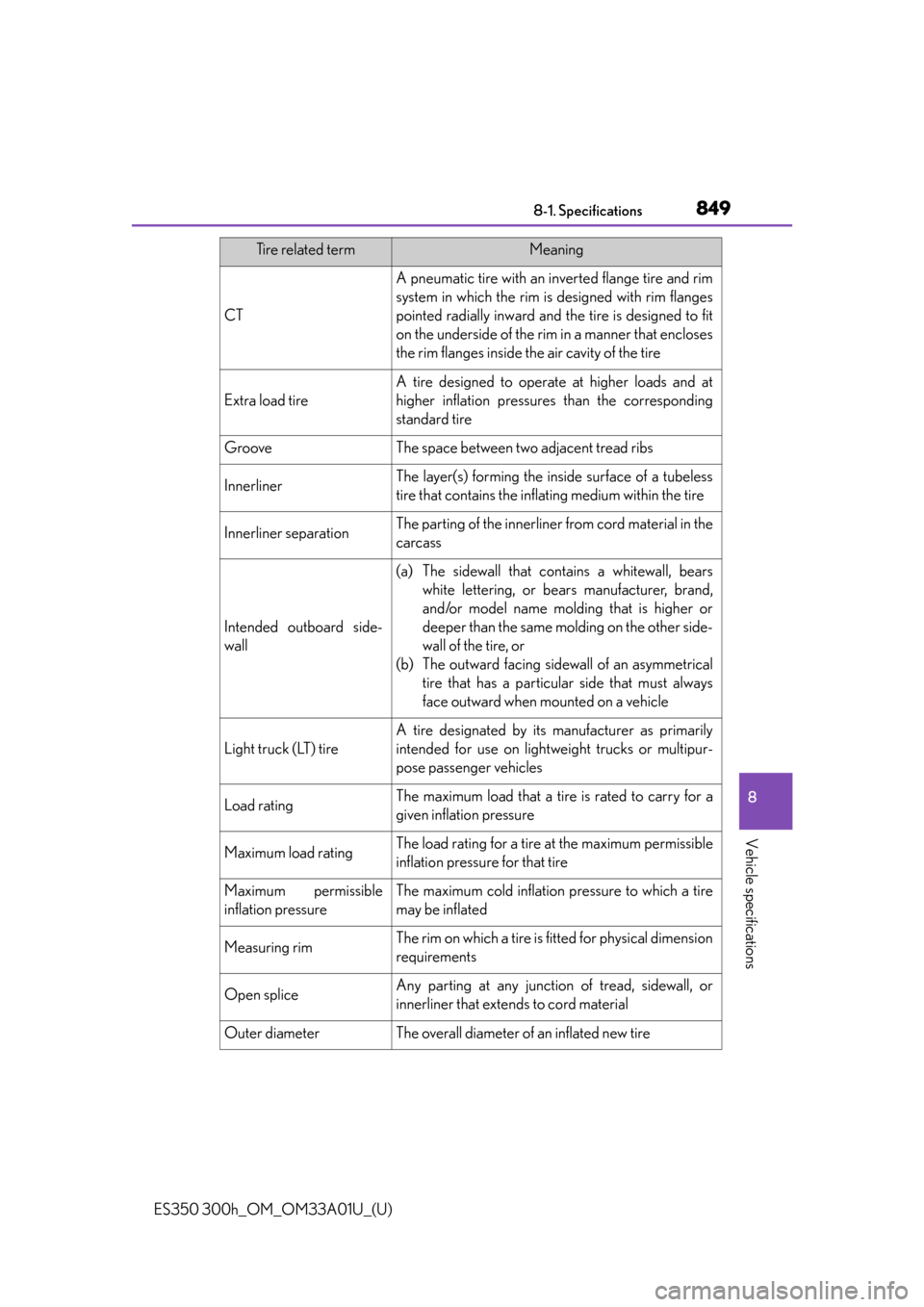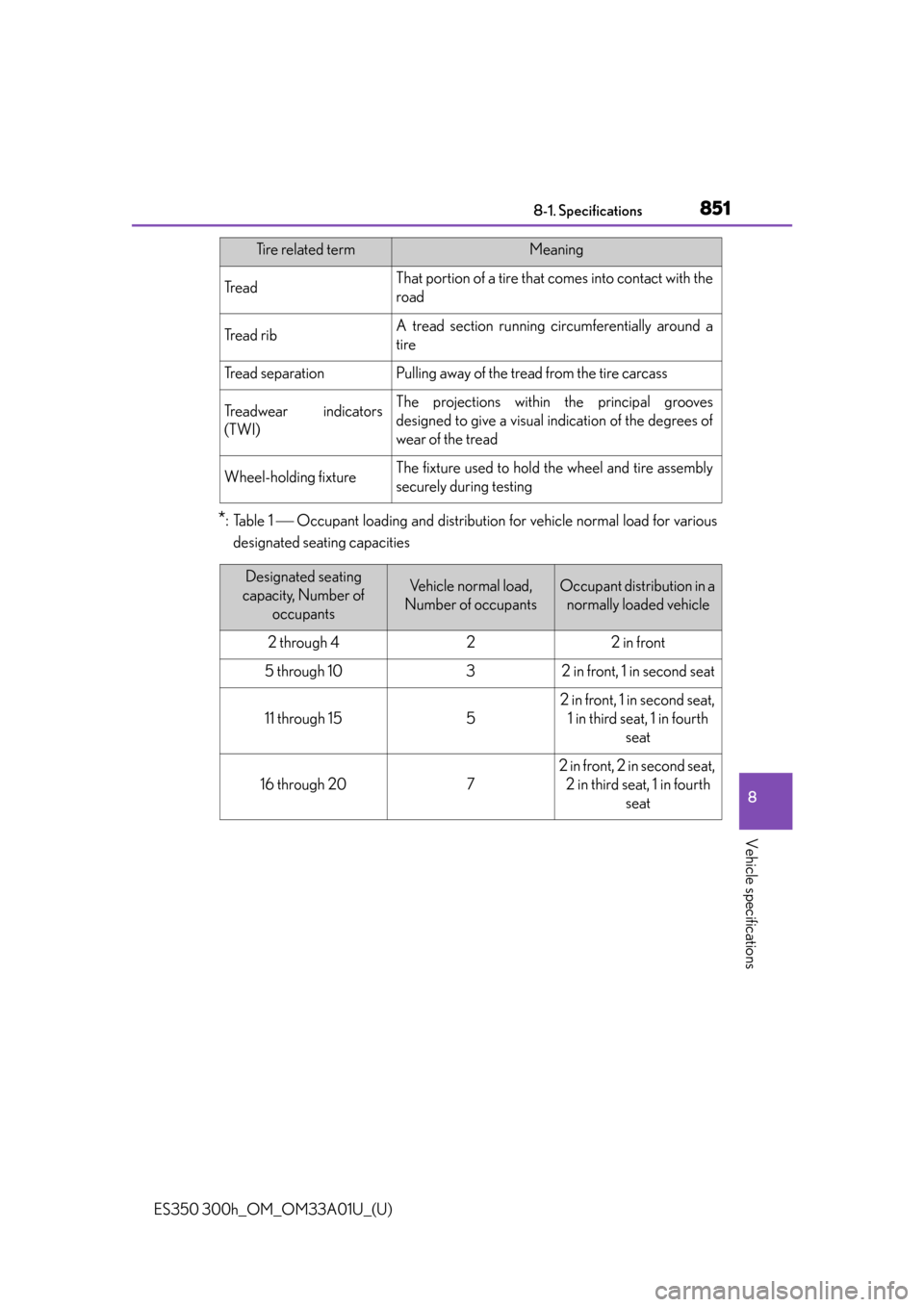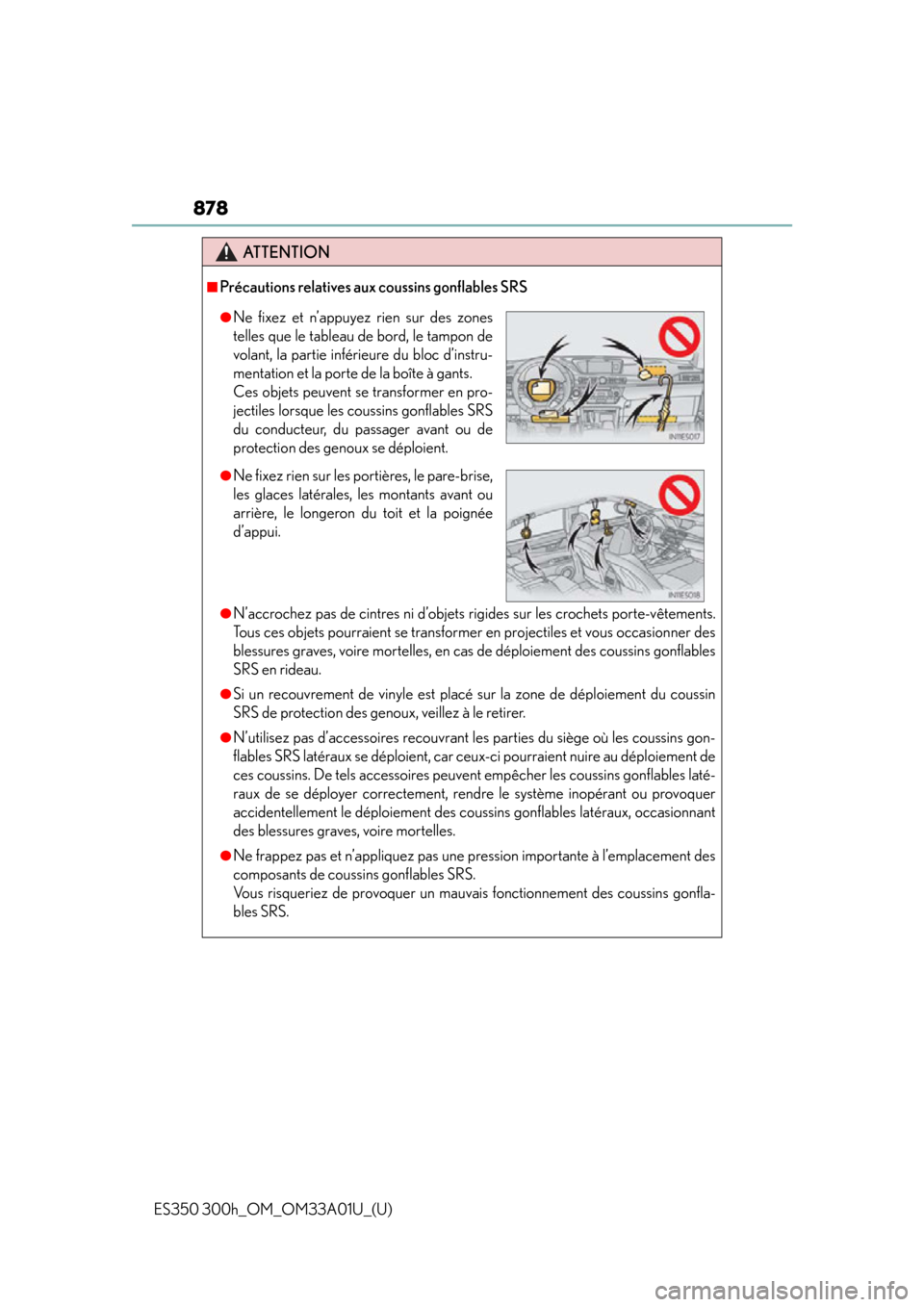Page 848 of 908

848
ES350 300h_OM_OM33A01U_(U)
8-1. Specifications
Rim diameter
(Wheel diameter)Nominal diameter of the bead seat
Rim size designationRim diameter and width
Rim type designationThe industry manufacturer’s designation for a rim by
style or code
Rim widthNominal distance between rim flanges
Vehicle capacity weight
(Total load capacity)The rated cargo and luggage load plus 150 lb. (68
kg) times the vehicle’s designated seating capacity
Vehicle maximum load on
the tireThe load on an individual tire that is determined by
distributing to each axle its share of the maximum
loaded vehicle weight, and dividing by two
Vehicle normal load on
the tire
The load on an individual tire that is determined by
distributing to each axle its share of curb weight,
accessory weight, and normal occupant weight (dis-
tributed in accordance with Table 1
* below), and
dividing by two
We a t h e r s i d eThe surface area of the rim not covered by the
inflated tire
Bead
The part of the tire that is made of steel wires,
wrapped or reinforced by ply cords and that is
shaped to fit the rim
Bead separationA breakdown of the bond between components in
the bead
Bias ply tire
A pneumatic tire in which the ply cords that extend to
the beads are laid at alternate angles substantially
less than 90 degrees to the centerline of the tread
CarcassThe tire structure, except tread and sidewall rubber
which, when inflated, bears the load
ChunkingThe breaking away of pieces of the tread or sidewall
CordThe strands forming the plies in the tire
Cord separationThe parting of cords from adjacent rubber com-
pounds
CrackingAny parting within the tread, sidewall, or innerliner of
the tire extending to cord material
Tire related termMeaning
Page 849 of 908

ES350 300h_OM_OM33A01U_(U)
8498-1. Specifications
8
Vehicle specifications
CT
A pneumatic tire with an inverted flange tire and rim
system in which the rim is designed with rim flanges
pointed radially inward and the tire is designed to fit
on the underside of the rim in a manner that encloses
the rim flanges inside the air cavity of the tire
Extra load tire
A tire designed to operate at higher loads and at
higher inflation pressures than the corresponding
standard tire
GrooveThe space between two adjacent tread ribs
InnerlinerThe layer(s) forming the inside surface of a tubeless
tire that contains the inflating medium within the tire
Innerliner separationThe parting of the innerliner from cord material in the
carcass
Intended outboard side-
wall
(a) The sidewall that contains a whitewall, bears
white lettering, or bears manufacturer, brand,
and/or model name molding that is higher or
deeper than the same molding on the other side-
wall of the tire, or
(b) The outward facing sidewall of an asymmetrical tire that has a particular side that must always
face outward when mounted on a vehicle
Light truck (LT) tire
A tire designated by its manufacturer as primarily
intended for use on lightw eight trucks or multipur-
pose passenger vehicles
Load ratingThe maximum load that a tire is rated to carry for a
given inflation pressure
Maximum load ratingThe load rating for a tire at the maximum permissible
inflation pressure for that tire
Maximum permissible
inflation pressureThe maximum cold inflation pressure to which a tire
may be inflated
Measuring rimThe rim on which a tire is fitted for physical dimension
requirements
Open spliceAny parting at any junction of tread, sidewall, or
innerliner that extends to cord material
Outer diameterThe overall diameter of an inflated new tire
Tire related termMeaning
Page 850 of 908

850
ES350 300h_OM_OM33A01U_(U)
8-1. Specifications
Overall width
The linear distance between the exteriors of the side-
walls of an inflated tire, including elevations due to
labeling, decorations, or protective bands or ribs
Passenger car tire
A tire intended for use on passenger cars, multipur-
pose passenger vehicles, and trucks, that have a
gross vehicle weight rating (GVWR) of 10,000 lb. or
less.
PlyA layer of rubber-coated parallel cords
Ply separationA parting of rubber compound between adjacent
plies
Pneumatic tire
A mechanical device made of rubber, chemicals, fab-
ric and steel or other mate rials, that, when mounted
on an automotive wheel, provides the traction and
contains the gas or flui d that sustains the load
Radial ply tire
A pneumatic tire in which the ply cords that extend to
the beads are laid at substantially 90 degrees to the
centerline of the tread
Reinforced tire
A tire designed to operate at higher loads and at
higher inflation pressures than the corresponding
standard tire
Section width
The linear distance between the exteriors of the side-
walls of an inflated tire, excluding elevations due to
labeling, decoration, or protective bands
SidewallThat portion of a tire between the tread and bead
Sidewall separationThe parting of the rubber compound from the cord
material in the sidewall
Snow tire
A tire that attains a traction index equal to or greater
than 110, compared to the ASTM E-1136 Standard
Reference Test Tire, when using the snow traction test
as described in ASTM F-1805-00, Standard Test
Method for Single Wheel Driving Traction in a
Straight Line on Snow-and Ice-Covered Surfaces,
and which is marked with an Alpine Symbol ( ) on
at least one sidewall
Te s t r i mThe rim on which a tire is fitted for testing, and may be
any rim listed as appropriate for use with that tire
Tire related termMeaning
Page 851 of 908

ES350 300h_OM_OM33A01U_(U)
8518-1. Specifications
8
Vehicle specifications
*:Table 1 Occupant loading and distribution for vehicle normal load for variousdesignated seating capacities
Tr e a dThat portion of a tire that comes into contact with the
road
Tr e a d r i bA tread section running circumferentially around a
tire
Tr e a d s e p a r a t i o nPulling away of the tread from the tire carcass
Treadwear indicators
(TWI)The projections within the principal grooves
designed to give a visual indication of the degrees of
wear of the tread
Wheel-holding fixtureThe fixture used to hold the wheel and tire assembly
securely during testing
Tire related termMeaning
Designated seating
capacity, Number of occupantsVehicle normal load,
Number of occupantsOccupant distribution in a normally loaded vehicle
2 through 422 in front
5 through 1032 in front, 1 in second seat
11 through 155
2 in front, 1 in second seat, 1 in third seat, 1 in fourth seat
16 through 207
2 in front, 2 in second seat, 2 in third seat, 1 in fourth seat
Page 865 of 908
865
ES350 300h_OM_OM33A01U_(U)
8-3. Items to initialize
8
Vehicle specifications
Items to initialize
The following items must be initialized for normal system operation
after such cases as the batter y being reconnected, or maintenance
being performed on the vehicle:
ItemWhen to initializeReference
Maintenance data (U.S.A.
only)• After the maintenance is per- formedP. 6 5 8
Tire pressure warning system
• When rotating the tires
• When changing the tire infla-tion pressure by changing trav-
eling speed or load weight, etc.
P. 6 9 6
Page 869 of 908
869
ES350 300h_OM_OM33A01U_(U)
9
For owners
Seat belt instructions for Canadian owners (in
French)
●Tirez sur la ceinture épaulière
jusqu’à ce qu’elle recouvre entiè-
rement l’épaule; elle ne doit
cependant pas toucher le cou ni
glisser de l’épaule.
●Placez la ceinture abdominale le
plus bas possible sur les hanches.
●Réglez la position du dossier.
Tenez-vous assis bien au fond du
siège, le dos droit.
●Ne vrillez pas la ceinture de
sécurité.
The following is a French explanation of seat belt instructions extracted
from the seat belt section in this manual.
See the seat belt section for more detailed seat belt instructions in
English.
Utilisation adéquate de s ceintures de sécurité
Page 878 of 908

878
ES350 300h_OM_OM33A01U_(U)
ATTENTION
■Précautions relatives aux coussins gonflables SRS
●N’accrochez pas de cintres ni d’objets rigides sur les crochets porte-vêtements.
Tous ces objets pourraient se transforme r en projectiles et vous occasionner des
blessures graves, voire mortelles, en cas de déploiement des coussins gonflables
SRS en rideau.
●Si un recouvrement de vinyle est placé sur la zone de déploiement du coussin
SRS de protection des genoux, veillez à le retirer.
●N’utilisez pas d’accessoires recouvrant le s parties du siège où les coussins gon-
flables SRS latéraux se déploient, car ceux-ci pourraient nuire au déploiement de
ces coussins. De tels accessoires peuvent empêcher les coussins gonflables laté-
raux de se déployer correctement, rend re le système inopérant ou provoquer
accidentellement le déploiement des coussins gonflables latéraux, occasionnant
des blessures graves, voire mortelles.
●Ne frappez pas et n’appliquez pas une pr ession importante à l’emplacement des
composants de coussins gonflables SRS.
Vous risqueriez de provoquer un mauvai s fonctionnement des coussins gonfla-
bles SRS.
●Ne fixez et n’appuyez rien sur des zones
telles que le tableau de bord, le tampon de
volant, la partie inférieure du bloc d’instru-
mentation et la porte de la boîte à gants.
Ces objets peuvent se transformer en pro-
jectiles lorsque les coussins gonflables SRS
du conducteur, du passager avant ou de
protection des genoux se déploient.
●Ne fixez rien sur les portières, le pare-brise,
les glaces latérales, les montants avant ou
arrière, le longeron du toit et la poignée
d’appui.
Page 887 of 908
887What to do if... (Troubleshooting)
ES350 300h_OM_OM33A01U_(U)●
When a warning light turns on or a warning message is dis-
played, refer to P. 751, 761.
●Stop the vehicle in a safe place an
d replace the flat tire with the
spare tire. ( P. 7 8 4 )
●Try the procedure for when th e vehicle becomes stuck in mud,
dirt, or snow. ( P. 820)
A warning light turns on or a warning message is displayed
When a problem has occurred
If you have a flat tire
The vehicle becomes stuck